Excellent ANIMATED 32 Sword form DIAGRAMS
https://www.philcheung.com/TaiChi/s32_08_s.htm
~~~~~
Analysis and Descriptions
32 Standardized (Orthodox) Simplified Sword Form Movement Sequence
© Michael P. Garofalo, Green Way Research, Valley Spirit Taijiquan, 2006-2018
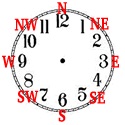 0. Preparation and Opening
0. Preparation and Opening
Stand with feet together or less than shoulder width. Face to the North (N12). Hold the sword in the left hand, with the sword along the back side of the left arm, sword tip facing up. Rest the hands at the side of the hips. Take up the Wuji meditation posture: stand up straight, relax body and mind (sung), sink energy to dan tien, tuck the bottom of the pelvis slightly forward, hold the chin slightly tucked, keep the crown of head held high, keep the lips slightly parted, rest the tongue on the roof of the mouth behind the front teeth, keep your weight centered over hips and legs in central equilibrium (zhong ding), etc. This is a preparation posture for beginning to root the feet and legs into the power of the earth, ground the energetic forces (Qi) of the body, center and concentrate the mind (Yi) on the task at hand, and raise the spirit (Shen) by Returning to the One.
Execute a ceremonial bow as is appropriate to your Taijiquan school’s tradition and practice. Many raise hands to chest height, touch hands or cross the hands, bow the head, then return the hands to the side of the hips. Many Yang style players do a “Raise Hands and Lower Hands” movement. They raise both hands, palms down, on an inhale, to about chest height, and then lower both hands back to sides of the hips on the exhale.
Stand quietly in Wuji meditation for awhile to gain mental, physical and spiritual composure. Quiet the mind. Become fully present in both time and place. Focus on being here and now. Wuji stands for “no limit, emptiness, nothingness, without definition, before all movement, spontaneity, freedom and chaos”; whereas, Taiji stands for “at the limit, after movement, multiplicity, space-time emergence, extreme limits, yin and yang evolution, regularity, law and cosmos.”
“In Daoist ritual the first act is also called, “calling the qi to order.” To call the qi to order one must first invoke the Perfected Warrior, Zhen Wu. This is done by standing still using the physicality of the method described above. It is a totally ready stance–able to instantaneously issue force in all directions. But Zhen Wu is not just a physicality, he is a whole way of seeing the world, and he is the first stage in the practice of jindan (golden elixir). Zhen Wu is visualized in his armor with skin like the night sky drawing inward, chain and silk is woven into his hair. He has bare feet and he is energetically on the edge of his seat. Think of him as holding a sword in one hand, without a sheath, the tip of the blade is dragging on the ground. He is the embodiment of the taijiquan concept song (or sung, let go, sink) he is utterly fearless, the god of nothing-to-lose.”
– Weakness With a Twist – Daoist Ritual Standing
Step to the left (W9) with the left leg. You are now in position 1a as shown below. Settle into a stable centered stance, knees slightly bent, legs about shoulder width apart. You should be facing to the North (N12). Hold the sword in the left hand, tip of the blade point up to the sky, sword behind the left arm. Rest the hands at the side of the hips. The index finger and middle finger are on the side facing forward along with the back of the hand, both fingers extended downward; the thumb, ring finger and little finger all curl around and hold the sword on the hilt.
32 Sword Form Pamphlet by Geoffrey Hugh Miller. Adapted from information and graphics found on the 32 Sword Form webpage by Michael P. Garofalo. 22 pages, 9/7/2015, PDF Format.
List of Movements, Complete 1-32, Valley Spirit Taijiquan List (PDF format)
Part One: Movements/Postures 1 – 8
1. Three Rings Around the Moon (1a-1g)

This movement, #1, has various names: Three Rings Around the Moon, Circling the Moon Three Times, Place Feet Together and Point Sword, Point Sword with Closing Steps, Dragonfly Dips Water, Three Halos Around the Moon, Three Rings Envelop the Moon.
Begin by facing to the N12 direction. The sword is in the left hand, with the sword facing upward (1a). The left hand is down along the left hip, with the sword being held in the reversed holding position (fanwo). The right hand is held in the sword hand position (index and middle finger pointed, thumb curled and touching the ring finger). The position of the empty hand is also called the “finger sword” (jianjue, qijian). Raise both hands to shoulder height (1a). Turn upper torso to the right side to face NE2, raise left hand and sword to eye level (1c), lower right hand to waist. Step with left foot back to face W9, and place left leg in a left bow stance (i.e., 70% of weight in left leg, 30% in right leg). Turn torso to face W9. Extend right arm forward towards W9. Bring left hand and sword to left hip, sword facing upward (1d). Position 1d is sometimes called: The Immortal Points the Way, The Fairy Shows the Way (仙人指路, Xian Ren Shi Lu). Moving from 1c to 1d corresponds to the Yang Taijiquan hand form movement called ‘Brush Knee.’
[A note on the illustrations.]
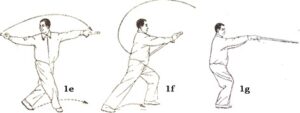
Step forward with right leg, right foot facing N12. Bend both knees and squat down a little in a twist step stance, with left knee tucked behind right knee (1e). Open right arm and extend arm to point with sword hand to E3 (1e). Extend left hand to point to W9, sword behind left arm. Look back to E3 (1e).
Step forward with left leg into a left bow stance, turning the torso to facing W9 (1f). Draw sword back and up in clockwise circular manner (1f0 to end with sword facing W9 (1g). Torso is acing W9 (1f). Transfer sword from left hand to the right hand (1f). Bring right foot up to left foot and bend knees, torso facing W9 (1g). Extend arms to W9 at chest height (1g). Lower the tip of the sword towards floor (1g). 1g is called “Point Sword with Feet Together.”
All of steps 1a – 1g are done in a flowing, graceful, and slow manner. When a part of the body is moving, all other parts of the body are moving in a smooth coordinated manner. For example, at the “finish” of 1e all parts of the body arrive in their positions at the same time. Emphasize coordinated and timed flowing, and avoiding any jerkiness.
At the end of each movement or posture, the sword blade is held in a specific position. The blade of the sword can be held with the “sharp” edge of the sword held in a vertical or perpendicular position, one edge pointing directly down to the floor the other to the sky, the zhimian position. The blade of the sword can be held with the “sharp” edge of the sword held in a horizontal or parallel position relative to the floor, the sword blade flat relative to the ground, the pingmian position. Finally, the blade of the sword can be held with the “sharp” edge of the sword held at an angle relative to the floor, tilted to the side, slanted, or angled to the right or left side. In position 1g, the sword blade edge is held in a vertical position relative to the floor, zhimian.
In general, during the practice of Taiji sword, the posture is held upright, we stand tall, we keep our back straight, we relax the shoulders and chest, we center the weight in the waist, we draw our chin in slightly, and we keep the crown of the head held high. We strive for nimbleness, alertness, poise, precision, and dignity.
Keep in mind that although the one sentence at a time descriptions that follow might imply a kind of step-by-step or one-two-three mechanical and jerky sort of movement sequence, in actual practice the movements “flow” smoothly together. Sometimes, multiple movements of the arms and legs occur simultaneously. When practicing alone at home, be sure to carefully study the DVDs, VHS, or UTube video demonstrations or instructions (listed above) on how to perform, to move, to play, to dance, to properly perform this 32 sword form. Sword forms are fluid, graceful, controlled, and expressive.
I have chosen to describe the movements using the clock diagram shown on this page, starting the 32 sword from a position of facing N12. Once you know how to do the 32 sword form, you can begin your sword practice facing in any direction that is convenient depending upon time and place. For example, when I practice the 32 sword form outdoors in the early morning, I begin by facing NW10:30 and move along a SW8 and NE2 line, so I don’t face the low morning sun as much.
2. The Big Dipper (2a-2d)

This movement, #2, has various names: Big Dipper, Standing on One Leg and Thrusting the Sword, Standing on One Leg to Thrust, Thrust Back Independently, Opposite Pierce with One-Leg Stand, Big Dipper Constellation, Big Chief Star.
Begin by stepping back (2a) with the right leg with foot at N12 (2b). Draw sword in arc down to point to NE1. Raise sword to point directly upward. Turn torso to look to NE1 (2c). Draw left leg back to toe stance. Transfer weight into the right leg. Look to NE1 (2c). Draw left leg in the air, knee facing W9, balancing on right leg. Lift sword over head, and point sword tip to W9, sword parallel to floor (2d). Extend left arm to W9, fingers in the sword hand position. Look towards W9 (2d). Position 2d reminds us of the Yang Taijiquan hand form position called ‘Golden Rooster Stands on Right Leg.’ In position 2d, the sword blade edge is held in the vertical position relative to the floor, zhimian.
“Chen Weiming calls the empty hand (predominately the left hand) literally “the hand pinched into a secret sword (shou nei jian jue), which is know elsewhere as “finger sword.” I have rendered it “feigned sword.” The empty hand keeps the feigned sword position throughout the form, with only a few exceptions that will be noted, such as when supporting the back of the hand holding the sword. In general, the empty hand follows the sword hand. This task serves to counter-balance the sword, to back it up energetically, to support the sword hand physically, and quite practically, to keep the empty hand out of the path of the sword.”
– Barbara Davis, Taiji Sword and Other Writings, p. xv.
Symbolism and Lore about the Big Dipper Posture
3. The Swallow Skims Across the Water (3a-3c)
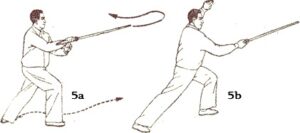
This movement, #3, has various names: Swallow Skims Across the Water, Swallow Skimming Across the Water, Sweep the Sword with Falling Step, Crouch Down and Sweep Sword, Swallow Skims Over the Pond.
Begin by drawing the left foot down to floor, and step back with left leg to SW7 (3a). Swing sword in arc down and point sword to NE2 (3a). Right leg in bow stance (3b). Touch left hand to right wrist (3b). Turn the torso to face W9 (3c). Pivot on left heel till left foot pointing SW7. Left leg in bow stance (3c). Swing sword from NE1 down and up in arc to point to W9. Sword pointed slightly up at chest height towards W9. Left hand raised above head, left arm out from body, with left palm facing to S6 (3c). Right palm holding sword is up. In position 3c, the sword blade edge is held at an angle relative to the floor.
On the above book cover, Petra Kobayashi demonstrates The Big Dipper (3a) and The Swallow Skims Across the Water (3b). He draws the right knee very low for 3b, and then draws the sword very low along the ground and then upward. The rising movement (2c,2d) and then the deep lowering movement (3a,3b) provides those with more strength, flexibility, and martial arts athletic skills the opportunity to show a more dramatic demonstration of the transition between the movements 2 and 3.
When in group or private classes with a Taijiquan teacher, please very carefully follow your teacher in class and repeat, mimic, and replicate the movements as he or she demonstrates them to you. In most cases, the specific movement sequencing and positioning will be pretty close to what is described herein; nevertheless, when differences occur, follow your instructor’s demonstrations and all the details that they teach. Teachers have different styles of teaching: some say very little, some always do the form all the way through every time, some modify the forms somewhat to suit their temperament and physical skills, some will break the form into each movement and have you drill each movement over and over before proceeding, some encourage outside study using media and print resources, some provide more information on the martial arts applications, etc. The student just needs to adapt, be flexible, be open-minded, show respect to the teachers, and always remember the distinction between the purpose/benefits/spirit of the activities and the details of the activities.
4. Block and Sweep to the Right (4a-4b)
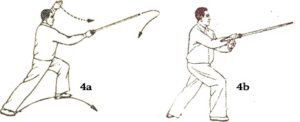
This movement, #4, has various names: Block and Sweep to the Right, Drawing the Sword to the Right, Carrying the Sword to the Right, Level Bringing to the Right, Right Slice with Bow Stance, Sweep to the Right.
Begin by pushing the sword forward a little towards W9 (4a). Turn right palm down and rotate the sword in a tight counterclockwise circle. Step forward with right leg into right bow stance (4b). Left fingers touch right hand holding sword (4b). Front of body faces W9. Position 4a reminds us of the Yang Taijiquan hand form position called ‘Fair Lady Works the Shuttles.’ In position 4b, the sword blade edge is held at an angle relative to the floor.
5. Block and Sweep to the Left (5a-5b)

This movement, #5, has various names: Block and Sweep to the Left, Drawing the Sword to the Left, Carrying the Sword to the Left, Level Bringing to the Left, Left Slice with Bow Stance, Sweep to the Left.
Begin by pushing the sword forward a little towards W9 (5a). Turn right palm up and rotate the sword in a tight clockwise circle. Step forward with left leg into left bow stance (5b). Left foot and knee aim towards SW8. Sword is pointed slightly up at chest height towards W9. Left hand raised above head, left arm out from body, with left palm facing to S6 (5b). Right palm holding sword is up. Front of body faces W9. In position 5b, the sword blade edge is held at an angle relative to the floor.
6. Searching the Sea (6a-6d)

This movement, #6, has various names: Little Dipper, Small Star of the Big Dipper, Sounding the Sea, Split Independently, Wheel Chop Sword with One-leg Stand, Small Star of the Literary God.
Begin by stepping forward with the right leg (6a) and placing the right foot by the left foot (6b). Lower the left hand (6a) down to touch the right wrist (6b). Rotate at the waist and turn to look to SE5 (6c) as you draw the sword down in an arc towards SE5 (6b) and then up and moving in an arc (6c) to finally point the sword down to NW10 (6d). Step forward to NW10 with the right leg. Turn the torso to face W9. Raise the left leg up with knee high and the left foot turned inward (6d). Balance on the right leg. Left hand is raised above head, left arm out from body, with left palm facing to SW7 (6d). Point the sword downward, with the blade in a vertical position. Look at the tip of the sword. In position 6d, the sword blade edge is held in a vertical position relative to the floor, zhimian.
7. Holding the Moon (7a-7b)
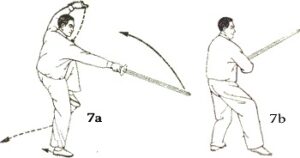
This movement, #7, has various names: Step Back and Pull the Sword, Holding the Moon, Withdrawing Sword in Empty Stance, Sword Withdraws and Feet Retire, Embrace the Moon.
Begin by lowering the left leg and stepping back (7a) with left foot. Draw the left hand down (7a) towards left hip. Bring the right hand back towards the body (7a) and move the end knob and handle down to the left hip. The left fingers touch the right hand. The sword points up at an angle (7b). The body faces to W9. Touch the right toe on the floor, drawing the body weight back into the left leg in a toe stance (7b). Look forward to W9. In position 7b, the sword blade edge is held in a vertical position relative to the floor, zhimian.
This posture (7b) is repeated in 30b below.
8. The Bird Returns to the Tree at Dusk (8a-8b)
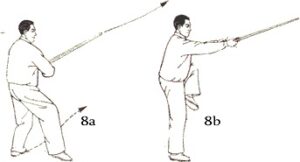
This movement, #8, has various names: Birds Returning to the Trees at Dusk, Split Upward Independently, Upward Pierce Sword with One-Leg Stand, Sleepy Birds Returning to the Forest, Birds Lodging in the Forest.
Begin by stepping forward slightly with the left foot (8a). Shift weight into the right leg, drawing left leg off the ground with the knee high (8b). The left foot is turned inward. Extended both arms with sword pointed upward in W9 direction (8b). Both hands hold the sword, with the palms facing upward. In position 8b, the sword blade edge is held in a horizontal position relative to the floor, pengmian. Look forward towards W9 towards the tip of the sword.
Part Two: Movements/Postures 9 -16
9. The Black Dragon Whips His Tail (9a-9b)
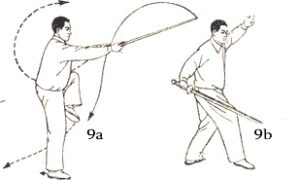
[A note on the illustrations.]
This movement, #9, has various names: Black Dragon Whips His Tail, Dragon Sweeping Tail, Sever Downward with Empty Step, Empty Stance and Slice Downward, Dragon Whips Its Tail, Black Dragon Swings Its Tail.
Begin by lowering the left leg (9a) and moving it back so that the foot faced towards SW7 (9b). As the leg is draw back move the sword in a counterclockwise arc downward (slicing downward) so that the sword ends up pointing towards NW 11, and the sword hand’s palm is facing down (9b). The sword hilt is at about hip height. The left hand is moved from the forward position (9a) in a clockwise arc and ends being raised above head, left arm out from body, with left palm facing to SW8. The body is turned at the waist toward NW10 (9b). In position 9b, the sword blade edge is held in a angled or slanted position relative to the floor. The eyes look to NW10. Position 9b reminds us of the Yang Taijiquan hand form position called ‘White Crane Cools Its Wings.’
10. The Green Dragon Emerges from the Water (10a-10c)
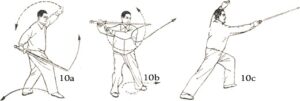
This movement, #10, has various names: Green Dragon Emerging from Water, Split with Left Bow Step, Pierce with Left Bow Stance, Green Dragon Comes out of the Water.
Begin by drawing the right leg back (10a) and place the foot facing N11; as the sword is lifted up and thrusted forward. Turn the torso to face N12 (10b). The right hand draws the sword to about face height, with palm facing down, with the sword flat relative to the earth. The left sword finger touches the right wrist. Draw the left foot near the right foot into a left empty stance (10b). Look to W9. Step to the left into a left bow stance (10c). The sword is draw in a clockwise arc (10b) and ends pointing to W9. The left hand is moved in a clockwise arc and ends being raised above the head, left arm out from body, with left palm facing to SW8 (10c). In position 10c, the sword blade edge is held, palm up, in a horizontal position relative to the floor, pengmian.
11. Turning Around and Carrying the Sword (11a-11c)

This movement, #11, has various names: Turning Round and Carrying Sword, Bring Diagonally and Turn Body, Pull-back Turn and Skew Slice Sword, Wind Curls Up Lotus Leaves, Wind Blows the Lotus Leaf.
Begin by drawing the weight to the right, while remaining upright. Pivot on the left heel, drawing the toes clockwise (11a). Draw the left sword finger hand to touch the right wrist at about chest height (11b). Draw the left leg next to the right leg (11b). Turn from the waist to the right in a clockwise arc. Step with the left leg towards SE4 into a left bow stance (11c). In position 11c, the sword blade edge is held in a horizontal position relative to the floor, pengmian. We are turning 195º from 11a to 11c. End in 11c by facing to the SE4. Look at the tip of the sword.
12. The Lion Shakes His Mane (12a-12b)
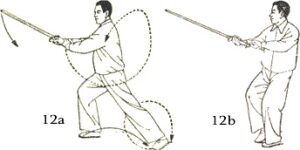
This movement, #12, has various names: Stepping Backward Carrying Sword; Bring Diagonally, Shrinking; Contract Body and Skew Slice Sword, Lion Shakes Its Head, The Lion Shakes His Mane.
I have seen conflicting demonstrations and descriptions of this movement amongst different teachers. Here are two of the options I have seen demonstrated:
1. Begin (12a) by drawing the left foot up next to the right foot, gently touching the toe to the ground. Then move the left foot back (12a). Draw the sword back towards the left side of the body in a counterclockwise arc (12a). Draw the right foot back into a right empty stance (12b). Draw the sword to the center. The torso and sword face towards E3. In position 12b, the sword blade edge is held, palm up, in a horizontal position relative to the floor, pengmian. The left sword finger touches the right wrist.
2. Begin (12a) by drawing the left foot up next to the right foot, gently touching the toe to the ground. Then move the left foot back. Step backward with the right foot to near the left foot (12b). Open the arms to the side (arms as in 13a, but feet reversed). The sword finger and sword both point towards the center, forming an inverted “V” shape. Step forward slightly with the right foot into a right empty stance (12b). Draw the sword to the center. The torso and sword face towards E3. The left sword finger touches the right wrist. In position 12b, the sword blade edge is held, palm up, in a horizontal position relative to the floor, pengmian.
13. The Tigress Holds Her Head (13a-13c)

This movement, #13, has various names: Tiger Holding Head, Sword Taken Up and Knee Lifted, Raise Knee and Hold Sword, Tiger Holds Its Head.
Begin (13a) by drawing the right foot back. Settle the weight back into the right leg. Step back just a little with the left toe. Open the arms (13b). The left sword finger and tip of the sword point to a center point in front of the body. The body faces E3. The right sword and sword finger kind of make a reverse V shape. Step forward slightly with the left heel (13b), and draw all the bodyweight into the left foot (13c). Move the right knee up off the ground, knee level with the right hip, right toe down and foot turned inward slightly (13c). Draw the right and left hands together in front of the chest. Place the left hand under the right hand and grasp the right hand. In position 13c, the sword blade edge is held in a horizontal position relative to the floor, pengmian. The body is facing E3. Look at the tip of the sword (13c).
© Michael P. Garofalo, Valley Spirit Taijiquan, Green Way Research, Red Bluff, California, January 2008.
14. The Wild Horse Leaps Over the Creek (14a-14d)

This movement, #14, has various names: Wild Horse Leaping Over Creek; Level Stab, Jumping; Jump and Flat Pierce Forward; Wild Horse Jumps the Stream; Mustang Jumps the Ravine.
Begin (14a) by stepping the right foot forward towards E3. Draw the full weight into the right leg in a deep bow stance. Extend both arms forward, thrusting the sword towards E3 (14b). Lean forward into right leg until you are about to loose balance and fall forward. Leap off the right leg and jump forward with the left foot (14b). Settle all the weight into the left foot, stand up straight, and raise the right toe slightly off the ground (14c). The hands separate from (14b) and are drawn down to the side of the hips (14c). Step forward from (14c) with the right leg into a right bow stance (14d). Extend the right arm forward and thrust the sword tip in the direction of E3 (14d). The right palm is held upward. In position 14d, the sword blade edge is held in a horizontal position relative to the floor, pengmian. The left hand is moved from the left hip (14c) upwards in a clockwise arc and ends being raised above head, left arm out from body, with left palm facing to N12. Look towards E3 at the tip of the sword.
15. Cutting Upward in a Left Empty Stance (15a-15c)

This movement, #15, has various names: Cutting Upward in Empty Stance, Hold Up with Left Empty Step, Swing Sword with Left Empty Bow Stance, Little Dipper, the Little Dipper Constellation.
Begin (15a) by stepping back with the right leg into a right toe stance (15b). Draw the sword in the right hand in a clockwise arc from the right side to the left side of the body, sword point up, drawing the left hand downward in a clockwise arc to about hip height, and hold the sword at about hip height. Bring the left sword fingers to the right wrist (15b). Turn the upper torso to face NW11 (15b), as you step forward with the right leg. Draw the sword downward in a wide counter-clockwise arc. Pivot on the right toe. Step forward with the left leg into a left empty stance (15c). Turn the body to have the torso face towards SE5, with the head and sword facing E3. Draw the sword up to about eye level. In position 15c, the sword blade edge is held in a vertical position relative to the floor, zhimian. The sword points to E3 and the eyes look at the tip of the sword (15c).
16. Scooping the Moon from the Bottom of the Sea (16a-16c)

This movement, #16, has various names: Scooping the Moon from the Sea Bottom; Hold Up with Right Bow Step; Swing Sword with Right Bow Stance; Scoop the Sea Bottom for the Moon; Fishing for the Moon at the Sea Bottom.
Beginning in position (16a), step forward slightly with the left foot. Draw the sword in a clockwise arc above the head from front to back, turning the torso to face back towards SW8 (16b). The sword is draw down to waist height, keeping the left sword finger on the right wrist (16b). Step forward with the right leg into a right bow stance, facing E3, as you draw the sword down and forward in a wide clockwise arc (16b). The sword is drawn upward with the wrist turning so that at the end (16c) the wrist is turned up. As you step forward into position 16c, the sword blade edge is held in a vertical position relative to the floor, zhimian. The left hand is draw in counterclockwise arc from the far right side (16c) to the left side, and ends being raised above the head, left arm out from body, with left palm facing to N12. Look towards E3 at the tip of the sword.
Part Three: Movements/Postures 17 – 24
17. The Rhinoceros Gazes at the Moon (17a-17d)

This movement, #17, has various names: Rhinoceros Gazing at the Moon, Withdraw Sword Rotating Body, Turn and Pull Sword Back, Shooting the Wild Goose.
Begin (17a) by pivoting on the left heel, and drawing the body weight into the right leg, sinking the right knee, and rotating at the waist so that the chest faces N12 (17b). Draw the sword from the right side to the left side, moving to the center of the body, holding the sword about face level, right sword finger touching left hand, with the sword pointed to R3 (17b). In position 17b, the sword blade edge is held in a vertical position relative to the floor, zhimian. Position 17b is called “Rhinoceros Gazes at the Moon.”
Draw the sword in a counter-clockwise arc over the body, from left to right, slicing downward with the sword. Lift the body upwards, move the weight into the right leg, and move the left leg back into an empty left stance (17d). As the sword is drawn back to the right hip, sword tip facing more upward (17d), move the left hand out, at chest height, sword finger pointing upward. In position 17d, the sword blade edge is held in a vertical position relative to the floor, zhimian. Position 17d is called “Shooting the Wild Goose.” Drawing one arm back and the other forward at shoulder height reminds one of the Yang hand form movement called “Repulse Monkey.”
18. The White Ape Offers the Fruit (18a-18b)
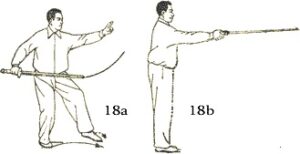
This movement, #18, has various names: White Ape Offering Fruit, Level Stab and Gathering Feet, Close Steps and Flat Pierce, White Monkey Presents Fruit.
Begin (18a) by stepping the left leg to the left, slightly back, and forward, keeping the knee bent slightly. Rotate the torso to the left until the chest faces W9 (18b). Bring the right foot up next to the left foot, again keeping the knees bent. Move the sword up to the center of the body, and place the left hand under the right hand. Slowly rise up to full height from the bent knee position. As you rise up, extend the arms outward at chest height, and thrust the sword forward. In position 18b, the sword blade edge is held in a horizontal position relative to the floor, pengmian. Gaze over the sword tip pointing to W9.
19. Parrying in a Left Bow Stance (19a-19c)
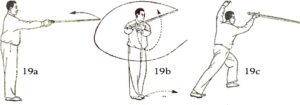
This movement, #19, has various names: Parrying in Left Bow Stance, Block with Left Bow Step, Obstruct Sword with Left Bow Stance, Dusting in the Wind.
Begin (19a) by pivoting slightly to the left on the right heel. Turn the torso to face N1 as you move the left hand to the right side to touch the sword finger on the right hand. The sword is drawn in a clockwise arc towards N2, with both hands touching, then down and up toward the left side (19b). Step out with the left leg into a left bow stance with knee and torso facing towards SW8 (19c). The sword is drawn upwards, slicing upwards, palm up, and the sword blade edge is held in a angled position relative to the floor (19c). The right hand is draw in clockwise arc from the far right side (19b) to the far left side (19c), and ends being raised above the head, left arm out from body, with left palm facing to S6. Look towards the tip of the sword. The sword is held high, above the head, with arms away from the body. This position (19c) reminds us of the Yang hand form movement of “Fair Lady Works the Shuttles.”
20. Parrying in a Right Bow Stance (20a-20b)
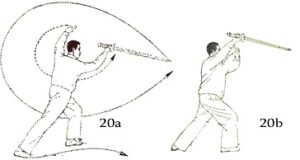
This movement, #20, has various names: Parrying in Right Bow Stance, Block with Right Bow Step, Obstruct Sword with Right Bow Stance, Dusting in the Wind.
Begin (20a) by stepping forward with the right leg into a right bow stance, with leg and torso facing NW11 (20b). As the right leg moves forward, the arms carry the sword in a wide counterclockwise arc upwards from right to left and then downwards from left to right (20a). The left arm also follows a counterclockwise arc and comes to rest on the right wrist at the end of the movement (20b). The sword blade edge is held in a angled position relative to the floor (20b). Look towards NW11. The sword is held high, above the head, with arms away from the body (20b).
21. Parrying in a Left Bow Stance (21a-21b)
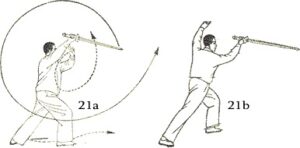
This movement, #21, has various names: Parrying in Left Bow Stance, Block with Left Bow Step, Obstruct Sword with Left Bow Stance, Dusting in the Wind.
Begin (21a) by pivoting slightly to the left on the right heel. Turn the torso to face N1 as you move the left hand to the right side to touch the sword finger on the right hand. The sword is drawn in a clockwise arc towards N1, with both hands touching, then down and up toward the left side (21b). Step out with the left leg into a left bow stance with knee and torso facing towards SW8 (21b). The sword is drawn upwards, slicing upwards, palm up, and the sword blade edge is held in a angled position relative to the floor (21b). The right hand is draw in clockwise arc from the far right side (21a) to the far left side (21b), and ends being raised above the head, left arm out from body, with left palm facing to S6. Look towards the tip of the sword (21b). The sword is held high, above the head, with arms away from the body. This position (21b) reminds us of the Yang hand form movement of “Fair Lady Works the Shuttles.” Position 21b is a repetition of 19c.
22. Pushing the Boat with the Current (22a-22c)

This movement, #22, has various names: Stepping Forward and Piercing Back, Advance and Thrust Forward, Step Forward and Opposite Pierce, Push Boat with the Current; Twist, Advance and Thrust.
Begin (22a) by stepping forward with the right leg into a twist step type of stance with the right knee and foot pointing to N12 (22b). The left knee is tucked behind the right knee (22b). As we step forward with the right leg, we turn the torso to the right bringing the center of the body to face N12 (22b). As the body turns right, the sword is drawn downward in a counter-clockwise arc movement from the left side to the right side. The sword points to E3 and we look towards E3 (22b). The left arm moves downward and then points to W9 (22b). From 22b, step forward with the left leg, moving into a left bow stance facing W9 (22c). Draw the sword from right to left in a counter-clockwise arc, moving the sword to thrust in the direction of W9 (22c). Move the left hand sword finger to touch the right wrist. Hold the sword about head level and point the sword tip slightly down (22c). The sword blade edge is held in a vertical position relative to the floor, zhimian. Look towards the tip of the sword towards W9.
23. The Comet Chases the Moon (23a-23b)
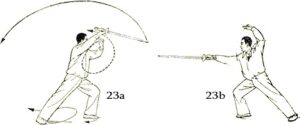
This movement, #23, has various names: Comet Chasing the Moon, Turn Body and Split Back, Reposition and Chop Back, Shooting Stars Chase the Moon, The Flying Star Chasing the Moon.
Begin (23a) by transferring the weight of the body into the right leg while bending the right knee. Pivot on the left heel, then gradually turn the torso to the right, clockwise from W9 towards E3. Draw the sword overhead in a clockwise arc as you turn the torso to the right side (23a). Pivot on the right heel, then draw the right leg back towards the left leg in a right empty stance. Continue to turn to the right until your chest faces E3. Step out with the right heel towards E4 and gradually settle into a right bow stance (23b). The sword cuts downward until the blade is at shoulder height, with the tip of the sword facing E3. The sword blade edge is held in a vertical position relative to the floor, zhimian. The left hand ends being raised above the head, left arm out from body, with left palm facing to N12. Look towards E3 at the tip of the sword.
24. The Heavenly Horse Gallops Across the Sky (24a-24b)
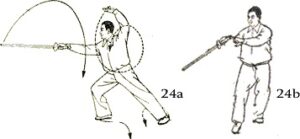
This movement, #24, has various names: Heavenly Horse Flying Across the Sky, Point Sword with Empty Step, Point Sword with Empty Stance, Heavenly Horse Galloping Across the Sky, Flying Horse in the Sky.
Begin (24a) by moving the left leg more towards the right into the center of the body, and then step forward with the left leg into an empty left stance. At the same time, turning the torso counter-clockwise to face N12. The sword is raised up to above the head, palm facing up, with the sword facing E4. The left hand is draw down to about waist height. (I think that there should be another illustration here between 22a-22b.) Next, bring the weight down into the left leg, and step forward with the right leg into a right empty toe stance. The torso faces at a slight angle towards N1. The sword rises in an arc and then cuts downward. Both arms are extended out at about shoulder height, with the left hand touching the right wrist, palms facing down. The wrists are bent, and the sword is held so that the sword tip is low, pointing to the earth. . The sword blade edge is held in a vertical position relative to the floor, zhimian. Gaze towards the tip of the sword.
Part Four: Movements/Postures 25 – 32
25. Lifting the Door Curtain (25a-25b)
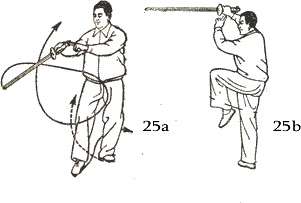 This movement, #25, has various names: Standing on One Leg and Lifting Sword, Independent Level Support, Hold Sword with One Leg Up, Hook Up the Curtain, Lifting the Door Curtain.
This movement, #25, has various names: Standing on One Leg and Lifting Sword, Independent Level Support, Hold Sword with One Leg Up, Hook Up the Curtain, Lifting the Door Curtain.
Begin (25a) by stepping back with the right leg behind the left leg. Bring the right knee behind the left knee in a twist step stance. At the same time as stepping back, bring the sword upward, palms facing up, left hand touching right wrist, and point the sword towards E2. Move the sword in a counter-clockwise arc from right side up towards the left and then down, as the body sinks into more of a squatting position. (I think another illustration is needed here between 25a-25b.) Continue to swing the sword in an counter-clockwise arc from low right to high left. As the sword moves upward, gradually rise up from the squatting position turning the body to face E3, and lifting the left leg up, drawing the knee upwards pointing towards E4, standing on the right leg (25b). The arms move up to slightly above the head. Hold the sword parallel to the floor, with the sword blade edge held in a vertical position relative to the floor, zhimian. The right palm faces S6, and the left sword fingers touch the right hand. Gaze towards E3.
26. Left Wheeling Chop Into a Right Bow Stance (26a-26c)

This movement, #26, has various names: Cutting in a Bow Stance, Split with Bow Step, Hang-up Chop with Right Bow Stance, Left Wheeling Sword, Left Cart Wheels Sword.
Begin (26a) by stepping forward with the left leg and placing the right knee behind the left knee in a twist step (26b), as the body turns to face N12. As the body turns to the left the sword is drawn down in a clockwise arc from left to right (26a-26b). The left hand continues to touch the right wrist until the arms reach the waist (26b). The left hand releases from the right wrist at the waist. The sword the continues upward in a clockwise arc (the Cart Wheel or Wheeling Chop movement) and then chops or cuts downward (26b). The left arm is drawn in a counter-clockwise arc to a position above the head. The body turns to face towards E3, stepping forward with the right leg into a right bow stance. The sword stops at shoulder height, sword tip pointing to E3, with the sword blade edge held in a vertical position relative to the floor, zhimian. The left hand ends being raised above the head, left arm out from body, with left palm facing to N12. Look towards E3 at the tip of the sword.
27. Right Wheeling Chop Into a Right Empty Stance (27a-27c)

This movement, #27, has various names: Cutting Downward in Empty Stance, Split with Empty Step, Wheel Chop with Empty Stance, Right Wheeling Sword.
Begin (27a) by rotating the right heel to point the foot towards SW4 as you drawn the weight slightly back into the left leg.. Step forward with the left leg in a curve until the left foot faces toward NW2. As the body turns to the right the sword is drawn down in a counter-clockwise arc from left to right (27a-27b). The left hand is drawn towards the right shoulder (27b). The head looks to SW7 and the sword points to SW7. Rotate the right palm upward. The sword the continues upward in a counter-clockwise arc (the Cart Wheel or Wheeling Chop movement) and then chops or cuts downward (27b-27c). As the sword swings forward and downward (27b), the torso turns to the left, the right leg steps forward into a right empty stance (27c), with the right toe facing N1 (27c). As the body turns, the left arm is drawn in a clockwise circle to the left and then back to center. The sword cuts downward and ends pointing towards the earth at an angle, with the sword blade edge held in a vertical position relative to the floor, zhimian (27c). The left sword finger touches the right elbow. The right wrist is relaxed, sword tip pointing downward. The torso is turned towards N1 (27c).
28. The Phoenix Spreads Its Wings (28a-28b)
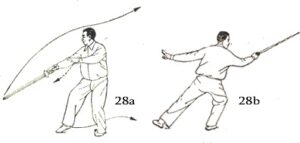
This movement, #28, has various names: Giant Geese Spreading Wings, Counter Attack with Feet Withdrawn, Retreat Step and Attack Backward, Phoenix Spreads Its Wing, Great Roc Spreads Its Wings, The Condor Spreads Its Wings.
Begin (28a) by stepping with the right leg backwards until the right toe faces SW7, ending in a right bow stance (28b). The left leg pivots on the left heel and the left foot turns to the right. The sword slices upward, backwards, in a clockwise arc until the sword is pointing to SW7, at about shoulder height. Pivot on the right heel to the left. The left hand releases from the right forearm and opens so as to point to E2. The sword blade is held at an angle, palm up. Look towards the sword blade (28b).
The movement from 28a to 28b reminds us of the Yang Taijiquan hand form movement called ‘Slant Flying.’
“In the northern depths, there is a fish called the Kun It is countless leagues in size. This fish changes into a bird whose name is the Roc. Its back is countless leagues in breadth. When it rouses in flight, its wings are like clouds draping down over the heavens. The sea begins to move, as this bird is about to migrate to the southern depths, the Pool of Heaven.”
– Zhuangzi, 300 BCE
29. The Bee Enters the Hive (29a-29c)

This movement, #29, has various names: Stepping Forward to Thrust, Steps Forward Making Level Stab, Step Forward and Flat Pierce, Wasp Enters Its Nest, Yellow Bee Returns to Nest, The Hornet Flying Into the Hive.
Begin (29a) by drawing the left leg back to the right leg, and lifting the left foot off the floor, and bringing the knee up. (29b). The torso turns to the left to face S6. Draw the sword blade in a counter-clockwise arc toward the left so as to bring the sword to shoulder height, blade tip pointed to E3 (29b). The left sword finger is drawn toward the right to the right shoulder. Step forward with the left leg and heel towards E3. Then step forward with the right leg into a right bow stance (29c). As the legs move towards E3, the torso also turns to the left until the chest faces E3 (29c), and the left hand is drawn in an arc towards the left side. The sword is thrust forward towards E3, held a shoulder height, palm up, with the sword blade horizontal relative to the floor, pengmian. The left hand ends being raised above the head, left arm out from body, with left palm facing to N12. Look towards E3 at the tip of the sword.
30. Holding the Moon (30a-30b)
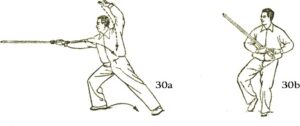
This movement, #30, has various names: Withdrawing Sword, Draw Back with T-Step, Pull Back Sword with T-Stance, Embrace the Moon, Holding the Moon with the Arms, Holding the Moon to the Bosom, Withdrawing the Sword in an Empty Stance.
Begin (30a) by drawing the right hand towards the body and then moving the right hand down to the left hip area. Step back with the left leg into a left empty stance. Turn the torso towards the left side, chest facing N12 (30b). Look towards E3. The sword tip points upward, the sword blade is held in a vertical position relative to the floor, zhimian; and the left sword finger touches the right wrist (30b).
This sequence and posture (30b) also appears in 7b above.
31. The Wind Sweeps the Plum Blossoms (31a-31d)

This movement, #31, has various names: Wind Sweeping the Plum Blossoms, Turn and Erase, Rotate and Flat Slice, Wind Sweeps the Plum Blossoms, The Wind Sweeping the Plum Flower Petals, Plum Flowers Being Swept by the Wind.
Begin (31a) by stepping with the right leg forward and to the right, toe pointing towards SE4 (31b). Rotate sword so that the palm of the right hand is facing down (31a-31b). The left sword fingers are on the right wrist. Turn the body to the right in a clockwise circle, and as the body rotates keep the sword at about chest height, blade parallel with the floor. Swing the left leg in a clockwise arc and then place the left foot so that the toes face W9, as the body rotates to face W9 (31c). Swing the right leg in an arc back to the right and end by placing the foot to point to NE1. The arms open and lower to waist/hip height. The left hand points to NW10 and the right hand to NE2 (31d). The sword tip points to N12, the sword blade at an angle. The chest faces N12. Draw the left leg into the body and take a left empty stance, with the weight in the back right leg (31d).
32. The Compass Needle (32a-32d)

This movement, #32, has various names: Thrusting Forward in a Bow Stance, Step Straight with Bow Step, Forward Pierce with Left Bow Stance, Compass Needle Pointing North/South, The Compass Needle and Closing.
Begin (32a) by stepping forward with the left leg towards NW11 into a left bow stance. Thrust the sword forward at chest height towards NW11 (32b).
Draw the weight back into the right leg, pivot on the left foot until the toe face N12. Turn the torso towards NE2 as the sword is drawn back to the body, bending the right elbow (32c). Grab the hilt of the sword with the left hand (32c). The left hand moves forward as the sword is brought back behind the left arm, hilt facing down, sword tip to the sky, as the left hand is brought back beside the left thigh (32d). Bring the right foot forward until the feet are in line, toes and torso facing N12, knees slightly bent, feet shoulder width apart (32d). Draw the right hand up to about the nose, then slowly lower the right sword finger down, palm facing the earth. As the right hand lowers, the knees unbent. When the right hand comes down along the right thigh you should be standing up straight (32d).
Conclusion, Closing, Ending
Stand in position (32d). Feet are shoulder width. Stand up straight, head held high. Sword is in the left hand, sword tip pointed upwards. The left hand is in the sword fingers position holding the sword hilt behind the hand. Look forward to N12. Right hand is alongside the right leg (32d). Maintain this position for awhile. Step with the left leg and bring the left foot beside the right foot.
STAFF FORM
(As remembered from a 2-week crash course from Phil Ho)
These instructions assume prior knowledge of another staff form or Tai Chi solo form.
TERMS:
Change L or R means to change the left or right palm from up to down or visa-versa.
R End means the end of the staff held by the right hand.
CW means clockwise from your point of view.
CCW means counter clockwise from your point of view.
Pull means to pull the staff back through the loosely closed forward hand.
Push means to extend the staff forward through your loosely closed forward hand. North, South (N., S.) indicates the direction you will move into.
HAND TECHNIQUES:
Chopstick fingers: If your palm is facing up (under the staff), slide your index finger over the top, then slide your thumb under, and then the last 3 fingers over the staff. Now your hand is palm down. Reverse the order to change from palm down to palm up: fingers slide under staff, thumb slides up over staff, and finally the index finger slides under.
Baton twirl: Your forward right hand is palm up near the center of the staff; the left hand is to the rear and palm down. Slide the left hand up until it touches the right. Rotate the staff CCW pressing the staff back over the backside of the left hand. Turn the left hand thumb down while continuing to rotate the staff – the palms now face each other (R forward, L back.) Grip the staff with the left hand & let go with the right. Continue the rotation with the left hand. The right hand catches the staff when the palms become Yin-Yang (opposed).
FORM
SALUTE: Face N. Place the staff vertically at your right side behind your shoulder with right hand thumb up holding staff against your hip. Raise the L. arm to the R. waist then out to the L. by the face with the palm inward CCW. Step L. with L. foot & shift weight to L. with the hand. Turn to palm out then to palm up as the hand comes back under by the waist and up to chest level. Meanwhile, lift the staff up and move the bottom end across to the left and around in a CW circle. The staff should always be perpendicular to the center point of the circle (about at the solar plexus) until about chest height on the R. then rotate the staff to horizontal. Shift weight to R. End the circle by grasping the staff with the left hand at chest level as it completes 360 degrees. Stand up on R. leg & bring in L. foot. Open palms by turning thumbs down to allow staff to roll down to your elbows, circle palms and press together as if in prayer and bow. Stand up and lower arms to roll staff out to palms. Raise arms to shoulder height and spread arms apart.
DIGGING L, R, and L: Change right to palm down, step back with right foot to face E. Dig under with the staff left end. Push and spiral up to your right and coming to rest facing East. Weight on the back R. foot, turn the toes of the R. foot forward E. Pull, change L&R palms, step back with L. foot, and dig under with the staff right end. Push and spiral up to your left ending E. Weight on back L. foot; turn toes of left foot forward E. Pull, change L&R, step back with R. foot and dig as before.
DIAGONAL HIT FORWARD: Pull, change L&R, hit diagonally over the top with the weight shifting forward. Push. The bottom L. end of the staff is beside your left hip. You are still facing E.
BATON TWIRL: Follow the instructions above and shift your weight back onto your R. foot and twist to the L while rotating the staff. When the staff is at the rear-most position, begin to rotate the waist back to the R. shift weight forward and hit upward (as if to someone’s knee) with the left end of the staff. End with the staff diagonally across your chest, R. hand by your R. ear facing E.
OVERHAND HIT (Repulse Monkey) R & L: Rotate the staff over so that the forward L. palm is down, R. hand at R. hip. Pull, change R&L, and step back with L. foot. Push and hit diagonally down over your shoulder to the E. Weight on back L. foot; turn toes of R. E. Repeat on the left side stepping back with the R. foot facing E.
HIGH PAT HORSE: Pull, change R. & L., lift up L. knee, hit down levelly with R. end of staff while the L. end comes up under your R. arm pit facing E.
CROSS HANDS HIT: Lower the body on the R. leg, L. heel on the ground. Turn L. toes out while lowering R. end of staff towards the L. toes. Continue rotating the staff in an E/W direction CW, changing R. & L. during the rotation. Weight shift to L. foot, step to the E. with R. foot hook step and then step behind the R. foot to the E. with a L. empty step while hitting down with L. hand end of staff near L. foot. Body faces N., eyes on staff end.
SPIN AROUND & HIT DOWN: Pass the R. end of the stick past the toes towards the W. and spin heel (R. & toe (L. around to your left passing the L end of the staff overhead. End up with feet on an E. -W. line in a horse stance & roll the L hand over so that the thumb turns down.
GREAT HORIZONTAL CIRCLE: Pass the staff overhead onto the shoulders and step (empty) back to the W. with the L. foot. Rotate around & swing the staff horizontally & levelly catching it with the L. hand thumb up mid-chest height.
JUMP TURN & HIT: Either leap into the air & spin or step over with the L. foot to the E. hitting down with the staff in a horse stance.
GREAT VERTICAL CIRCLE: Turn towards the W. weight shifting to L. foot passing the staff to the W. over your head with the L. hand coming in front of your forehead. (This looks like the Tai Chi move “Turn & chop with fist”) Make a vertical circle with the staff hitting down to the W. Lift up the body & raise your arm to pass the staff beside you & over the top. Step back with the R. foot & catch the staff about waist high with the L. hand looking W. in horse stance.
HI PAT, HIT L. & R.: Pull, change L. & R. lift L. knee, push & hit down levelly with the L. end under your R. armpit. Lower yourself down onto the heel of the L. foot. Turn toes of L. foot out and pass the R. end of the staff by the toes. Start rotating the staff vertically CW in the E. -W. direction & change L.R. Step forward in an arc with the R. foot & hit down levelly with the L end of the staff (R. end under L. armpit), weight onto R. front foot.
HIT R., BLOCK WITH L. PALM: Shift weight to L. foot, turn toes of R. out. Pass L. end of staff by the toes; rotate the staff E. -W. CCW while changing L. palm only, step forward with L. foot, push & hit down levelly with R. end of staff. Weight shift to L. foot. Bring L. hand from under armpit towards the W. pushing outward with the palm while bringing the R. end of the staff back beside your R. leg angled to match the forward leaning of your body. The L. end of the staff rotates around your R. shoulder blade.
SALUTE: Weight shift to R. foot, stand up bring L. foot beside R. Pass the L. end of the staff past the R. hip swinging to the E. & up with the R. end stopping vertically overhead Your L. hand grasps the staff thumb up waist high; you are facing N.
SPIN AROUND AND SPEAR EAST: Shift weight to R. foot, lift toes of left & spin around so that the body faces S. lowering the body & looking E. Spear back levelly to the E. changing the L. hand.
DOUBLE STEP & SPEAR WEST: Look W., shift weight to L. foot & step to the W. with the R. foot and then behind the R with the L. (empty). Thrust the staff to the W. levelly with the L. end held close as if playing a flute.
SPIN & THROW STAFF (“Pool Cue”): Spin to the L. with the L. end of the staff held closely & levelly. The weight stays on R. foot. The R. end of the staff swings wide. Shift weight suddenly to L. foot and throw & re-catch the staff out levelly to the W. to extend the hitting range.
HIT BACK & FRONT: Turn the body to the R. & hit vertically back to the E. with the L. end of the staff ending level (the R end is beside your L. ribs). Shift weight to the R. foot Then rotate to the L. shifting the weight to the L. foot while swinging the staff levelly around to the W.
KICK & SPEAR: Turn the toes of the L. foot to the L. & pull the R. hand close to your chest. Kick the L. end of the staff with your R. toe. Then as if following the force of the kick swing the staff overhead back to the E. until it becomes level. Step to the W. with the R. foot and spear to the W. with the R. end of the staff. Weight shift to the R. foot.
STEP UP, BLOCK L. & PADDLE R.: Step forward W. with the L. foot using a hook step. Pass the L. end of the staff beside the L. foot blocking low. Weight shift to the L. foot. Then stand up on the L. leg, lift the R. knee while passing the R. end of the staff from N. to S. (CCW) beside the raised R. foot as if paddling a canoe.
CORKSCREW SPEAR: Continuing the circular motion of the R. end of the staff, draw it back slightly and then spiral it forward CCW while stepping E. with the R. foot & spearing out to the E. with the R. end of the staff.
ROLLBACK, HIT LEFT & RIGHT: Shift the weight to the L. foot while moving the staff levelly to the W. beside you. Then hit with the staff overhead E. with the L. end levelly (the R. end is under your L. armpit) shifting the weight to the R. foot. Continue the staff motion shifting the weight back to the L. foot & turning the toes of the R. to the R., pass the L. end of the staff by the R. toes. Step forward to the E. with the L. foot hitting down with the L. end of the staff to the E.
DRUNKEN STICK: Place the L. end of the staff onto the ground beside your L. foot. Lean on the staff while hook stepping the R. foot to the E. Lean on the staff while “S” hooking your L. foot between the staff & R. foot out towards the E. Untwist the body by hitting down to the E. with the L. end of the staff.
VERTICAL GREAT SWINGS LEFT & RIGHT: Move your R hand to about 15” from the R. end of the staff. Shift the weight to the R. foot while rotating the staff around the R. hand towards the W. by throwing the L. end up & over the R. hand. Catch the extreme end with the L. hand and continue the motion by hook stepping forward with the R. foot to the E. and swinging the staff underneath towards the E. as if hitting far away knee height, weight on R foot, left hand comes to rest over your head. Next shift the weight to the L. foot, slide the R. hand back to touch the L. while flipping the R. end of the staff over to the W. Let go with the L. hand & re-catch the staff about 15” from the R. end. Continue the motion; hook stepping to the E. with the L. foot and swinging the staff underneath as before. Weight shift to L. foot.
VERTICAL CIRCLE TO CREEPING SNAKE: Turn to face W., slide L. hand down to meet the R. hand, turn to face W. while raising staff overhead. Swing far end downward towards the ground then lift the body while swing staff by your R. foot and back around overhead again hitting down to flat on the ground. Meanwhile, step back with R. foot and assume the “creeping snake” posture.
STEP UP, HIT DOWN: Rise up forward, pull, change L.& R., step to the W. with the R. foot while hitting down to the W. with the R. end of the staff.
TWISTING HIT DOWN: Pull, change L.& R. and twist around to the R. to face N. while hitting down to level with the middle of the staff.
BLOCK UPWARDS, TURN & HIT (helicopter move): Move the staff up over your head (block), then rotate the staff to place the R. end under your L. armpit while twisting to the L. to face E. Weight onto R. foot while the L. foot swings empty step behind (W.) on the toe to stop your body rotation.
STEP AND BLOCK: Drop the L. end of the staff while shifting the weight to the L. foot, Continue the motion while turning to the W. and stepping NW with the R. foot. The L. staff end continues up to the W. and circles around to the SW and then blocking low to the NW. Weight shift to the R. foot.
TURN & BLOCK: Pivot the staff around its center ending vertically with the L. hand above the R. while hook stepping with the L. foot around the rotating staff. Face E., weight shift to the L. foot.
STEP BACK, HIGH PAT: Step back to the W. with the R. foot, and do a high pat raising the L. knee.
CROSS HANDS HIT EAST: As before, but hit the ground with the L. end of the staff.
HIT DOWN WEST: Step out to the E. with the R. foot while hitting the L. end of the staff down to the ground W. in a CCW circle.
THROW DOWN EAST: Stepping behind you with the L. foot (empty) to the E., throw the R. end of the staff to the ground to the E. (let go & re-catch).
LOW BLOCK WEST: Step out to the E. with the R. foot, shift weight to R. foot, swing R. end of staff low to the W. across your front while turning to face the NW.
REVERSE PADDLE: Stand up on the R. leg & lift L. knee. Swing L. end of staff around to the S. CCW and block to the NW near your L. foot.
CONCLUSION: Put the L. foot down to the L., stab down L., shift weight L. Next, circle the L. end of the staff CW hitting high to the NE to your R. side while shifting the weight to the R. Next, rotate the staff in a CCW circle in a N. -S. direction. When the R. hand gets near your R. waist, let go with the L. hand and vertically circle it CCW to the W. coming to rest by your L. side. Meanwhile, shift the weight L. following the L. hand. Stand up on L. foot and bring the R. foot to the left. You should now be in your starting position.
Thanks to Stuart Eddy for documenting.